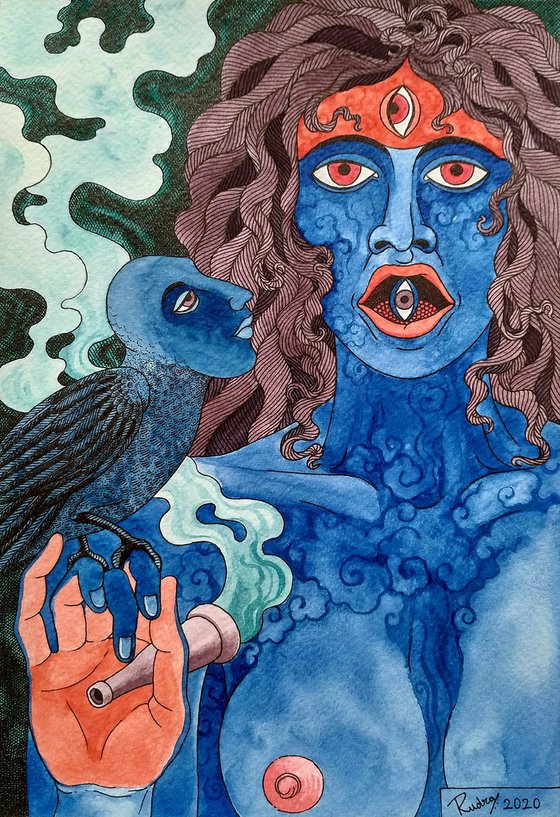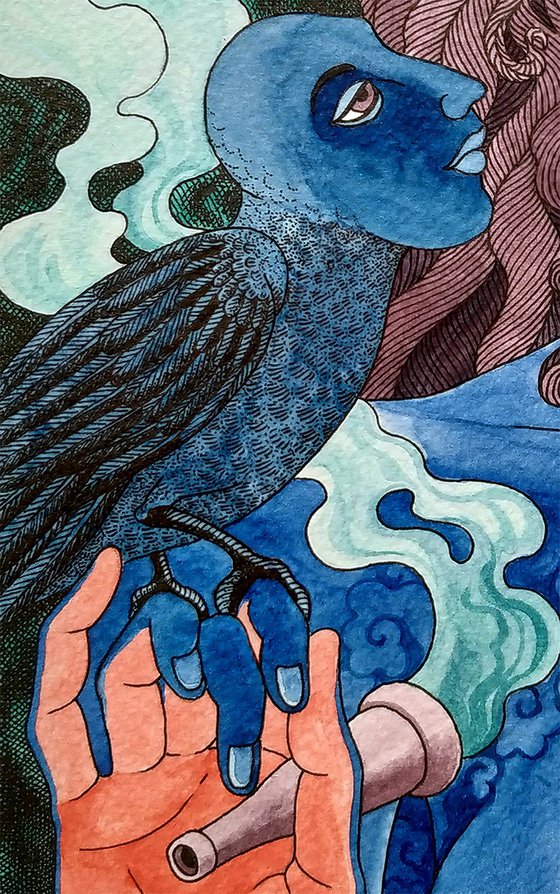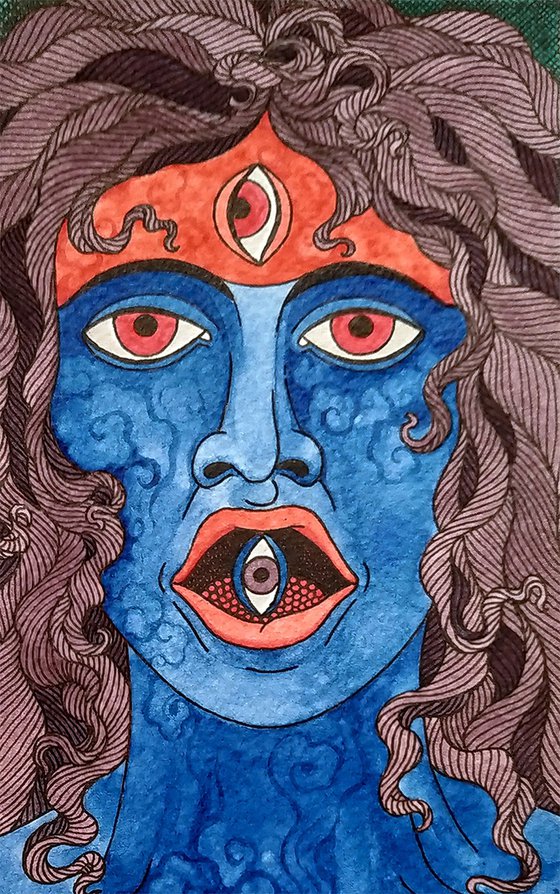Original artwork description:
The name ‘Dhuumavati’ denotes ‘one who is formed of smoke’. She is the void that exists before creation of the universe and after its destruction. She is the haze and smoke of ignorance that envelops all creation and keeps us intoxicated and attached to the world of illusion, ‘Maya’, but she is also the guide who shows us the path out of that smoke if we seek her out and ask for guidance. She is the embodiment of everything that we fear as inauspicious and unwanted because of our ignorance and greed in this material world, and our unwillingness to attain complete independence from what we consider ‘favourable’ to our aspirations. She blatantly tells us that our aspirations are going to go up in smoke (she is associated with the smoke that rise from the burning pyres at the cremation grounds) and we should look beyond such petty aspirations. She consumes all and she discards that which is unnecessary.
She is one of the Dasa Mahavidya (10 cosmic wisdom) and the Shakta mythology has three stories of her manifestation.
1. - Maha-Bhagavata Purana narrates that Sati, the first wife of Shiva, felt very angry and insulted by her father Daksha because he had not invited them to an auspicious fire sacrifice, arranged by him, where all the other divinities had been invited. Sati insisted that she should be allowed to go and confront her father for such an insult, but Shiva tried to stop her. In her rage Sati brought forth the Dasa Mahavidya and surrounded Shiva. Dhuumavati appeared at that time, along with the rest of the nine Mahavidyas.
2. - Shaktisamgama-Tantra narrates that after confronting her father Daksha at the Yagna, Sati gave up her will to live by burning herself in the fire sacrifice and Dhuumavati rose as the smoke from Sati's body. She is Sati, ultimately free of her worldly attachments and sense of honour or betrayal, and risen like smoke over Sati’s unsatisfied desires. Hence she is all consuming, and yet always unsatisfied.
3. - Pranatosini-Tantra narrates that once, Sati developed this insatiable hunger and kept asking Shiva to provide her with food. When Shiva declined, she devoured him whole to satisfy her extreme hunger. She was satiated and her body turned dark and smoke started emerging from her. Shiva pleaded her to disgorge him and set him free, she unwillingly obliged. Shiva then left her and cursed her to live as a widow. That is when Sati transformed into Dhuumavati.
What these narratives have in common is the dissatisfaction born out of unfulfilled desires and the self destructive nature of human ego, and most importantly the fierce transformation achieved after sacrifice of that ego.
Custom duty fee if any is payable by the buyer. Different Countries have different rules and regulations for packages being shipped in and the Custom duty fee varies as well. Such fees are not included in the shipping cost.
Materials used:
Watercolor and pen drawing with waterproof ink on textured acid free paper
Tags:
#nude #figurative art #surreal art #mythology #spiritiual #feminist art #symbolic art #feminine divine #iconography #hindu goddessAadi Parashakti (2) - Dhuumavati (2020)
Mixed-media painting
by Rudra Kishore Mandal
2 Artist Reviews
£781.98
- Mixed-media painting on Paper
- One of a kind artwork
- Size: 30.48 x 40.64 x 0.25cm (unframed) / 25.4 x 35.56cm (actual image size)
- Signed on the front
- Style: Surrealistic
- Subject: Nudes and erotic
Original artwork description
The name ‘Dhuumavati’ denotes ‘one who is formed of smoke’. She is the void that exists before creation of the universe and after its destruction. She is the haze and smoke of ignorance that envelops all creation and keeps us intoxicated and attached to the world of illusion, ‘Maya’, but she is also the guide who shows us the path out of that smoke if we seek her out and ask for guidance. She is the embodiment of everything that we fear as inauspicious and unwanted because of our ignorance and greed in this material world, and our unwillingness to attain complete independence from what we consider ‘favourable’ to our aspirations. She blatantly tells us that our aspirations are going to go up in smoke (she is associated with the smoke that rise from the burning pyres at the cremation grounds) and we should look beyond such petty aspirations. She consumes all and she discards that which is unnecessary.
She is one of the Dasa Mahavidya (10 cosmic wisdom) and the Shakta mythology has three stories of her manifestation.
1. - Maha-Bhagavata Purana narrates that Sati, the first wife of Shiva, felt very angry and insulted by her father Daksha because he had not invited them to an auspicious fire sacrifice, arranged by him, where all the other divinities had been invited. Sati insisted that she should be allowed to go and confront her father for such an insult, but Shiva tried to stop her. In her rage Sati brought forth the Dasa Mahavidya and surrounded Shiva. Dhuumavati appeared at that time, along with the rest of the nine Mahavidyas.
2. - Shaktisamgama-Tantra narrates that after confronting her father Daksha at the Yagna, Sati gave up her will to live by burning herself in the fire sacrifice and Dhuumavati rose as the smoke from Sati's body. She is Sati, ultimately free of her worldly attachments and sense of honour or betrayal, and risen like smoke over Sati’s unsatisfied desires. Hence she is all consuming, and yet always unsatisfied.
3. - Pranatosini-Tantra narrates that once, Sati developed this insatiable hunger and kept asking Shiva to provide her with food. When Shiva declined, she devoured him whole to satisfy her extreme hunger. She was satiated and her body turned dark and smoke started emerging from her. Shiva pleaded her to disgorge him and set him free, she unwillingly obliged. Shiva then left her and cursed her to live as a widow. That is when Sati transformed into Dhuumavati.
What these narratives have in common is the dissatisfaction born out of unfulfilled desires and the self destructive nature of human ego, and most importantly the fierce transformation achieved after sacrifice of that ego.
Custom duty fee if any is payable by the buyer. Different Countries have different rules and regulations for packages being shipped in and the Custom duty fee varies as well. Such fees are not included in the shipping cost.
Materials used:
Watercolor and pen drawing with waterproof ink on textured acid free paper
Tags:
#nude #figurative art #surreal art #mythology #spiritiual #feminist art #symbolic art #feminine divine #iconography #hindu goddessReturns and refunds
We want you to love your art! If you are not completely satisfied with your purchase you can return it free within 14 days, no questions asked. Learn more
Artist Reviews (2)
This artwork is sold by Rudra Kishore Mandal from India






